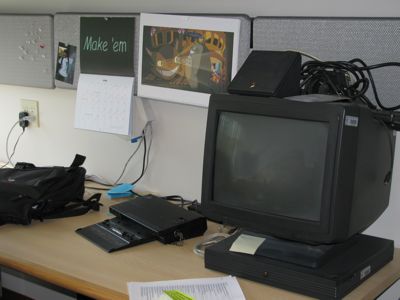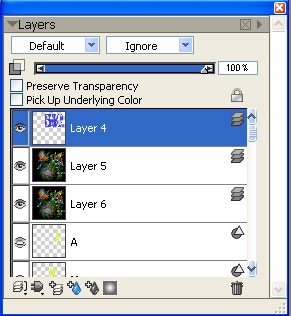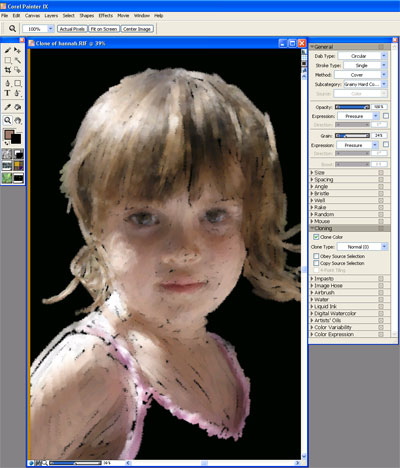The Cat with the Fresh Hat: Corel Painter Makes the Most of its 9th Life

Corel Painter has always been full of tempting features, sumptuous brushes, and texturally rich materials. But it has also been long on unusual, perplexing, and sometimes cumbersome interface conventions that have made it impractical to use in a production design environment. In short, it was too different from Photoshop, in too many ways, to co-exist comfortably with Adobe’s industry-standard image editing and painting tool. Painter IX, Corel’s latest edition of Painter, retains all the great natural-media tools of earlier versions, but adds a bundle of production-oriented features and a re-designed interface that makes it far more compatible with Adobe products, and one that can easily live under the same roof with Photoshop.
Although Painter, on its own, is a compelling creative application, it can’t live up to expectations without being coupled with a pressure-sensitive Wacom tablet, such as the new Intuos 3. The combination of pressure-sensitive stylus and drawing tablet, coupled with Painter’s brushes, which are designed to respond to the pressure and tilt of a Wacom stylus, comes closer than any other digital application to duplicating the process of painting on paper or canvas.
Orderly Workspace
The first most striking feature of Painter IX is the interface. Tools now live in neatly stacking floating palettes, grouped in logical ways that makes it possible to readily find what you’re looking for. Different types of materials, such as chalks, charcoals, oils and inks, are stored in a Materials pull-down menu, and variations of that type are stored in an adjacent Variants menu. Adustments to individual variations can be made in the comprehensive Brush Controls palette, which gives you access in one place to every possible setting for a given brush. This palette is intimidating, with its numerous stacked rollouts, but at least it lets you access all the complexity of Painter’s tools, whether or not you’re inclined to exercise all that control.
Working with layers and masks was always one of the frustrating aspects of Painter. Finally, Painter IX has a Layers palette that looks and feels almost identical to Photoshop’s, with very familiar-looking support for masks and channels (see Figure 1). The capability to easily manipulate and paint on layers is long overdue and it’s now much more reasonable to work with individual elements without obliterating the paint underneath. In fact, Painter now lets you open and save Photoshop files with all layers, channels, and masks intact, so you can now exchange work between the two applications nearly seamlessly. (Some features, such as wet paint on watercolor layers, do not carry over to Photoshop, however.)


Figure 1: Painter IX now has layers that looks, feels, and works much like Photoshop’s.
One feature I hoped to see in this version of Painter was a history palette, similar to Photoshop’s; however, Painter limits you to 32 or fewer levels of Undo and Redo, which is an arbitrary (and far too small) number, particularly given the preponderance of artist machines with fast processors and a gigabyte or more of RAM. For example, it’s very common to soar past 32 consecutive paint strokes when stippling dots or making patterns with paint strokes. At the very least, the number of undos should be user definable with the understanding that too many undo levels will impact performance. But it would be far preferable to have a history stack, like Photoshop’s, that shows the brush variant and color and allows for jumping back through an arbitrary number of paint strokes and other operations. On the other hand, at least Watercolor paints now remain “wet” from one painting session to the next, so you don’t have to finish a watercolor in a single session, and you can even edit the wetness of watercolor edges after painting.
One of the major changes in this version of Painter is in performance, and many brushes are at least twice as fast as before. From a practical standpoint, when running Painter IX on a recent-model Pentium 4 or G5 Mac, this is the first version where brush lag (the brush stuttering or jumping unnaturally to keep up with cursor movement) is almost never an issue.
Brushing Up
Although many of the changes to Painter IX are in the realm of interface and performance, there are a few breakthrough artist features as well. Perhaps most significant is the new Artists’ Oils brush type (see Figure 2). These brushes let you pick up a dab of paint from the palette, and apply it, until it’s “used up” on the canvas. The effect is closer than Painter has ever come to working with real paint on real canvas.
 Figure 2: The new Artists’ Oils brush does a good job of simulating the look of paint on canvas.
Figure 2: The new Artists’ Oils brush does a good job of simulating the look of paint on canvas.
I was mystified when trying to adjust the Artists’ Oils brushes to behave more like real brushes at the beginning of a paintstroke, which leave an oblong or streaking tail on the stroke, instead of beginning a stroke with a perfectly straight edge. It turns out you can adjust this in the Artist Oils section of the now-vast brush settings palette, by selecting a different brush tip and adjusting the Bristling, Clumpiness, and Trail-off sliders. But there are so many possible settings, that it’s very hard to guess which combination will have the desired effect. And I still haven’t figured out how to get various brushes to consistently react to my Wacom’s pressure and tilt sensitivity the way I expect .
One of the real production-oriented features in Painter IX is the capability to paint on paths, or along the boundaries of object masks. In the past, you could paint inside or outside a mask, but there was no way to stroke a path with a Painter brush. Now you can place type, and use Painter’s paint strokes to precisely paint over the type outlines, or import a masked image and paint neat strokes around it to create glows, outlines or line-drawing style illustrations using painterly brushes. You can also use the pen tool to draw Bezier curves, and paint along that path. Illustrators, and even architects, will appreciate the ability to create accurate, yet stylized drawings and renderings, and the feature is invaluable for type designers.
However, we would like to be able to set a curvature or distance tolerance so that brush strokes could extend away from the path and fade out when the brush is drawn past a corner, or dragged far enough away from a path; this would allow for architectural-style drawing where drafting lines are clean and accurate on an edge but extend naturally past breaks in curves and corners. As it stands, the tool can be a little too rigid. We found that when tracing type, for example, the brush would jump from a vertical line to a perpendicular curve that intersected it on a horizontal, resulting in the painted line actually cutting the corner.
Another feature that has been dramatically improved is Painter’s popular cloning functionality. This lets you trace over an existing photo or image with Painter’s brushes, resulting in a new painting that derives its color and lines from the original, with stylized paint strokes that conform to the style, paper grain, and stroke direction of the brushes and materials you choose (see Figure 3). If your assignment is to quickly produce illustrations that resemble a photograph in a painterly style, there is no more efficient tool. In Painter IX, this feature is much easier to use — you simply select the Quick Clone menu item, and choose a brush, before you go to work cloning an image.
 Figure 3: Painter’s cloning functionality — which lets you create art out of existing images — is much improved in version IX.
Figure 3: Painter’s cloning functionality — which lets you create art out of existing images — is much improved in version IX.
The new Painter now offers an opening screen that lets you dive into previous projects, start new projects, set up brushes, or browse sample artwork. It’s hardly a breakthrough feature, but it does make Painter more friendly for novice users.
Altogether, Painter IX is the best version yet, by far. It retains its excellent brushes, but has finally come around to a more standardized (i.e., Photoshop-style) interface, and it’s far more appropriate to creating professional artwork on a day-by-day basis.
Conclusion
Corel has brought Painter IX a long way. The new Photoshop-style layering — and more importantly, direct support for Photoshop files — as well as Artists’ Oils, and quick cloning features, are only some of the new features I like. Overall, the program’s faster and more user friendly.
A few things could still use work: Unlimited undos would be a good place to start. And I’d like to see support for Photoshop type, which can currently only be brought in as bitmap layers. Also, configuring brushes to behave like real-world paintbrushes — or to at least behave the way I want — can sometimes pose a mystery, since there are so many possible combinations of brush settings. Still, Painter is definitely up to the challenge of producing artwork daily in a production environment, and it’s the closest you’ll come to splattering paint on your clothes while making digital art.
This article was last modified on October 5, 2004
This article was first published on October 5, 2004



